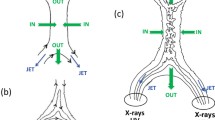Abstract
Meter-wavelength observations are presented for the solar radio storm of August 17–22, 1968. The data comprise dynamic spectra and high-resolution brightness distributions from the 80 MHz radioheliograph.
It is found that the storm consisted essentially of type III bursts at the lower frequencies and type I at the higher frequencies; the transition, usually near 60 MHz, was fairly sharp. The type I source was located over an active region associated with a large sunspot group. The type III position was displaced about 0.5 R ⊙ transversely from the type I, in a region of low magnetic field.
The evident close association between the two types of emission can best be explained by disturbances originating in the type I region, propagating outwards through a region of weak magnetic field, and triggering an electron acceleration process, probably at the cusp of a ‘helmet’ structure. The observed frequency and spatial relationship between the type I and type III components in events of this kind follow as a natural consequence of this model.
A comparison of these results with the hectometer-wavelength satellite observations of the 1968 August event makes possible a qualitative estimate of the outward path of the type III exciters through the corona, and it is apparent that below the solar wind region of the corona this path departs considerably from the radial direction.
Similar content being viewed by others
References
Boischot, A., de la Noë, J., du Chaffant, M., and Rosolen, C.: 1971, Compt. Rend. Acad. Sci. (France) 272, 166.
Fainberg, J. and Stone, R. G. L: 1970a, Solar Phys. 15, 222.
Fainberg, J. and Stone, R. G.: 1970b, Solar Phys. 15, 433.
Fainberg, J. and Stone, R. G.: 1971, Solar Phys. 17, 392.
Gordon, I. M.: 1971, Astrophys. J. Letters 5, 251.
Hanasz, J.: 1966, Australian J. Phys. 19, 635.
Kai, K.: 1970, Solar Phys. 11, 456.
McIntosh, P. S.: 1971, Asilomar Conference on the Solar Wind, Pacific Grove, California, 22–26 March, 1971.
McLean, D. J.: 1970, Proc. Astron. Soc. Australia 1, 315.
Malville, J. M.: 1962, Astrophys. J. 136, 266.
Newkirk, G.: 1961, Astrophys. J. 133, 983.
Palmer, I. D., and Lin, R. P.: 1972, Proc. Astron. Soc. Australia 2, in press.
Pneuman, G. W.: 1968, Solar Phys. 3, 578.
Sakurai, K.: 1971, Solar Phys. 16, 125.
Sturrock, P. A.: 1966, Nature 211, 695.
Takakura, T.: 1963, Publ. Astron. Soc.Japan 15, 462.
Trakhtengerts, V. Y.: 1966, Soviet Astron. AJ 10, 281.
Weiss, A. A. and Wild, J. P.: 1964, Australian J. Phys. 17, 282.
Wild, J. P. and Tlamicha, A.: 1964, Nature 203, 1128.
Author information
Authors and Affiliations
Rights and permissions
About this article
Cite this article
Stewart, R.T., Labrum, N.R. Meter-wavelength observations of the solar radio burst storm of August 17–22, 1968. Sol Phys 27, 192–202 (1972). https://doi.org/10.1007/BF00151783
Received:
Issue Date:
DOI: https://doi.org/10.1007/BF00151783




